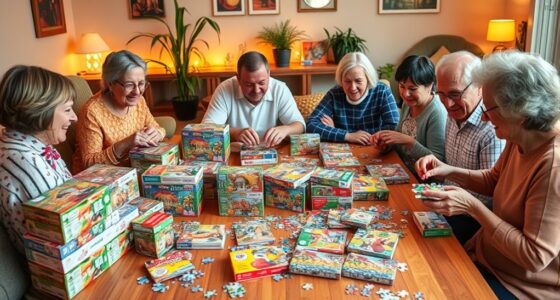To stop screen-time squabbles, create an indoor obstacle course that keeps kids active and engaged. Use household items like cushions, chairs, and ropes to build challenges that promote agility, balance, and coordination. Involving children in designing the course boosts their enthusiasm and ownership. This fun setup diverts attention from screens, encourages physical activity, and turns conflicts into opportunities for active play. Keep exploring to discover more ways to make this approach even more effective.
Key Takeaways
- Use an indoor obstacle course as a fun, engaging way to redirect kids’ energy away from screens.
- Involve children in designing the course to boost their enthusiasm and ownership of active play.
- Incorporate the obstacle course as a reward system to motivate kids to complete physical activities before screen time.
- Combine indoor activities with outdoor play to provide diverse movement options and reduce disputes over screens.
- Establish clear boundaries by linking screen privileges to participation in active, obstacle course-based challenges.

If your kids often argue over screen time, creating an indoor obstacle course can be a fun and effective solution. Kids crave movement and adventure, and an obstacle course offers a way to channel their energy without constantly battling over screens. By setting up a designated physical activity area inside, you give them a productive outlet that also helps establish healthy technology boundaries. This approach encourages kids to see physical activity as an exciting alternative to screen time, reducing the temptation to reach for devices out of boredom.
Designing an indoor obstacle course isn’t just about physical activity; it’s a strategic way to shift their focus from screens to movement. You can incorporate simple household items—cushions, chairs, ropes, or cardboard boxes—to create stations that challenge their agility, balance, and coordination. As they navigate the course, they develop a sense of accomplishment, which makes the activity rewarding and less likely to be replaced by screens. Plus, involving your kids in planning the course can boost their enthusiasm and ownership, making them more eager to participate.
While an indoor obstacle course provides a fantastic alternative, it’s also essential to promote outdoor alternatives whenever possible. Fresh air, sunlight, and open space are crucial for healthy development, and outdoor activities naturally reduce screen dependency. Encourage your children to step outside for a quick game of tag, a nature walk, or riding their bikes. These outdoor alternatives not only help burn off energy but also foster a connection with nature and improve overall wellbeing. Incorporating diverse activities ensures your children benefit from different types of movement and stimulation, which supports their physical and mental health.
Setting clear rules around technology boundaries is key to managing screen-time disputes. The obstacle course acts as a tangible reward system—kids can earn extra playtime or special challenges once they complete certain physical activities. This strategy helps them understand that physical activity is a positive, fun way to earn their screen privileges, rather than an outright ban. When you combine the indoor obstacle course with outdoor alternatives and firm boundaries, you create a comprehensive environment that promotes active play, reduces conflicts, and teaches self-regulation.
In the end, transforming screen-time disputes into opportunities for active, engaging play benefits everyone. Your kids learn to value movement as much as their devices, and you gain peace of mind knowing they’re spending time in healthy, constructive ways. An indoor obstacle course, paired with outdoor alternatives and clear boundaries, offers a practical, enjoyable solution to the age-old problem of screen-time squabbles. Integrating home technology considerations into your plans can further optimize the space and make active play more enticing.
Frequently Asked Questions
How Can I Adapt the Obstacle Course for Different Age Groups?
To adapt an obstacle course for different age groups, you should focus on age-appropriate modifications and creative adaptation. For younger kids, simplify tasks and guarantee safety, using softer obstacles or lower heights. For older children, add challenges like timed runs or tricky maneuvers. You can also incorporate their interests to make it more engaging. Adjusting complexity and difficulty keeps everyone motivated and safe, making the activity fun for all ages.
What Safety Precautions Should I Take During Installation?
Think of installing your obstacle course as preparing a ship for a voyage. You need to follow strict supervision guidelines, keeping a close eye on every detail. Inspect all equipment thoroughly to guarantee stability and safety. Secure mats and anchors tightly, and keep small parts out of reach. By taking these precautions, you create a safe environment, so your kids can navigate the course confidently without risking injuries.
How Often Should Kids Participate in the Obstacle Course?
When figuring out how often your kids should participate in the obstacle course, consider the activity duration and frequency guidelines. Aim for about 30 to 60 minutes of active play daily, depending on their age and energy levels. You might start with 3-4 sessions per week, ensuring they get enough physical activity without overdoing it. Always monitor their comfort and safety, adjusting as needed for their individual needs.
Can This Method Work for Very Active or Unruly Children?
This method can work wonders, even for the most energetic or unruly kids, like a magic wand for behavior management. You’ll need to incorporate plenty of activity variation to keep them engaged and motivated. With patience and consistency, an indoor obstacle course can channel their energy productively, helping them learn self-control while having fun. It’s a surprisingly effective way to turn chaos into cooperation and reduce screen-time battles.
Are There Cost-Effective Materials for Creating an Obstacle Course?
You can create an obstacle course using DIY alternatives and budget-friendly options. Look around your home for inexpensive materials like pillows, chairs, and laundry baskets to set up fun challenges. Use tape or chalk to mark pathways or boundaries. Repurposing items you already own helps keep costs low while still providing engaging activities. With a little creativity, you can build a safe, exciting course that keeps your kids active without breaking the bank.
Conclusion
So, next time your kids turn the living room into a digital battleground, just set up an indoor obstacle course. Who knew that dodging couch cushions could replace endless screen negotiations? With a little creativity—and maybe a few bruised knees—you’ll find that peace and quiet are just a few hurdles away. After all, what’s more satisfying than watching your kids conquer obstacle courses instead of their tablets? Truly, the ultimate parenting win.










